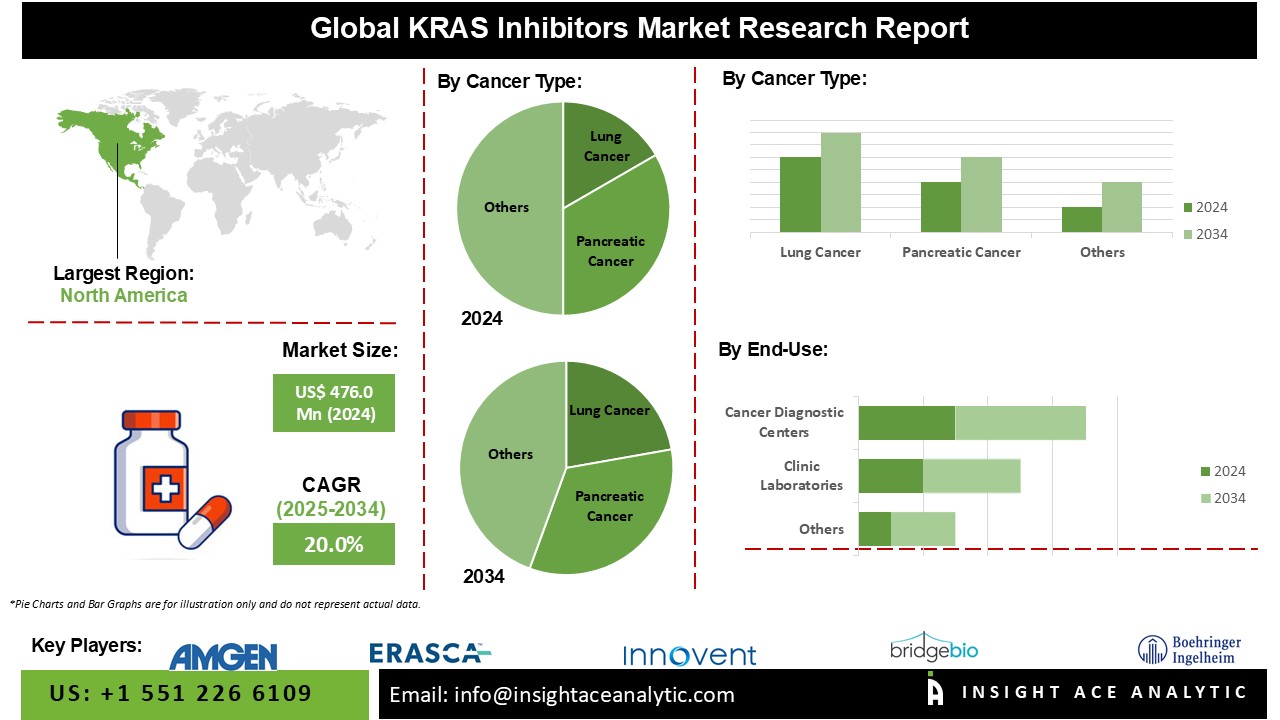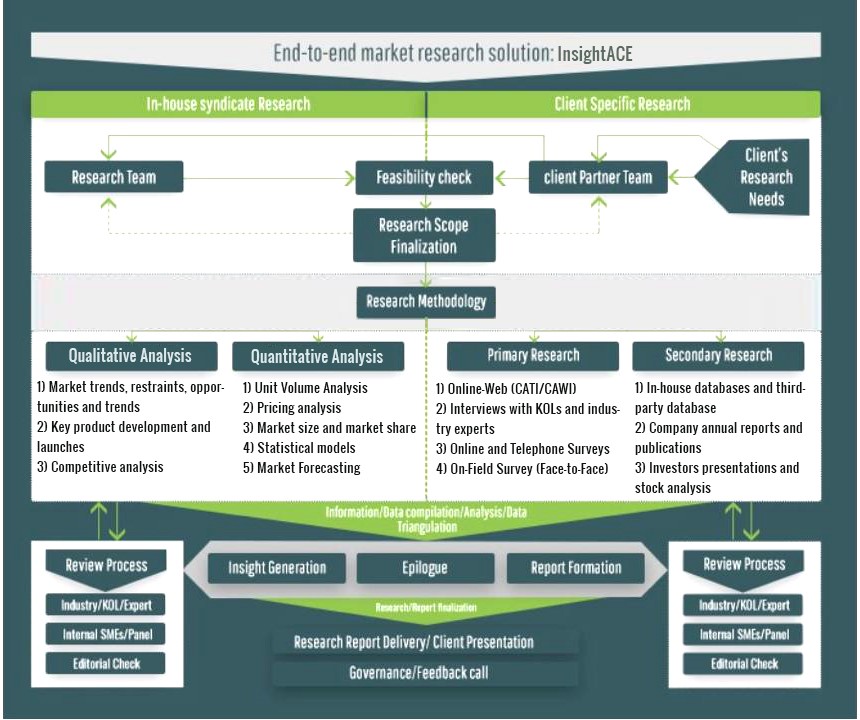KRAS Inhibitors Market Size is valued at USD 476.0 Mn in 2024 and is predicted to reach USD 2,916.8 Mn by the year 2034 at a 20.0% CAGR during the forecast period for 2025-2034.
Kirsten rat sarcoma viral oncogene homolog inhibitor genes encode a protein in many cell signalling pathways. Several cancers, including lung, colorectal, and pancreatic cancers, often include mutations in the KRAS gene. Carcinogenesis, or the unchecked growth of cells, can result from these alterations. A group of medications known as KRAS inhibitors has been developed to block the signalling pathways connected with the mutant KRAS protein. By blocking the aberrant cellular signalling brought on by the mutant KRAS gene, these medications hope to decrease the rate of cancer cell proliferation and metastasis. Kirsten rat sarcoma has become more necessary due to the rising incidence of lung cancer (KRAS). Recent advances in pharmaceutical research and the creation of novel anti-cancer drugs have contributed to the growth of the Kirsten rat sarcoma (KRAS) industry. These variables are expected to drive the market's expansion in the time allotted. Furthermore, Innovations in structure-based drug design and identifying new inhibitors have paved the way for creating potent KRAS inhibitors, which should lead to further market expansion.

However, the market growth is hampered by the strict regulatory criteria for the safety and health of the KRAS inhibitors market and the product's inability to prevent fog in environments with dramatic temperature fluctuations or high humidity KRAS inhibitors, a potential obstacle to market expansion could be the impatience with which the benefits of Kirsten rat sarcoma (KRAS) research are acknowledged. It is costly to pay for diagnostic tests performed in hospitals and labs. Critical investigations are still in progress. All of these factors have the potential to impede the market's growth. The pandemic of COVID-19 has highlighted the urgent need to hasten the creation of cancer care technology and encourage worldwide cooperation to tackle global health issues. Therefore, some of these challenges are anticipated to become more handleable and ultimately overcome in a post-COVID environment.
The KRAS inhibitors market is segmented based on cancer type and end-use. According to cancer type, the market is segmented into lung cancer, pancreatic cancer, colorectal cancer, and others. By end-use, the market is segmented into clinic laboratories, cancer diagnostic centres, hospitals, cancer research institutes, academic institutions, and others.
The Lung cancer KRAS inhibitors market is expected to hold a major global market share in 2023. Lung cancer patients have a disproportionately high number of KRAS mutations, which presents a substantial opportunity for the KRAS inhibitor market. Many lung cancer patients may find successful therapy choices if these mutations are targeted. There is a big, unfulfilled medical need for effective treatments for lung cancer, especially non-small cell lung cancer (NSCLC), which is a difficult illness to treat. There is a current medical need to treat KRAS-mutant lung cancer, and KRAS inhibitors provide a potential way to target these mutations precisely.
Cancer research institutes make up the bulk of KRAS inhibitors because of the growing number of collaborations between research institutions and biotech businesses and the expansion of clinical research, especially in countries like the US, Germany, the UK, China, and India.
The North American KRAS inhibitors market is expected to register the maximum market share in revenue in the near future. It can be attributed to the demand for targeted treatments in oncology, improvements in healthcare infrastructure, the frequency of KRAS mutations in different cancer types, and the pace of drug discovery and development, all potential drivers of market expansion in this field. In addition, Asia Pacific is estimated to grow rapidly in the global KRAS inhibitors market because the ageing population and the rising desire for effective treatment through personalized medicine are expected to propel the growth of regional markets in the next year. The region's market is anticipated to experience expansion due to the increasing emphasis on biotechnology and its technological advancements.
|
Report Attribute |
Specifications |
|
Market Size Value In 2024 |
USD 476.0 Mn |
|
Revenue Forecast In 2034 |
USD 2,916.8 Mn |
|
Growth Rate CAGR |
CAGR of 20.0% from 2025 to 2034 |
|
Quantitative Units |
Representation of revenue in US$ Mn and CAGR from 2025 to 2034 |
|
Historic Year |
2021 to 2024 |
|
Forecast Year |
2025-2034 |
|
Report Coverage |
The forecast of revenue, the position of the company, the competitive market structure, growth prospects, and trends |
|
Segments Covered |
By Cancer Type, End-User |
|
Regional Scope |
North America; Europe; Asia Pacific; Latin America; Middle East & Africa |
|
Country Scope |
U.S.; Canada; U.K.; Germany; China; India; Japan; Brazil; Mexico; France; Italy; Spain; South East Asia; South Korea |
|
Competitive Landscape |
Amgen, Boehringer Ingelheim, BridgeBio Pharma, Erasca, Innovent Biologics Inc., Incyte, Mirati Therapeutics, Novartis, Jemincare, Cardiff Oncology, Inc., Roche, Genentech, Verastem Oncology, Revolution Medicines, Immuneering Corporation, Jacobio Pharmaceuticals, Deciphera Pharmaceuticals, Elicio Therapeutics, InventisBio, Gritstone Bio, D3 Bio and Others |
|
Customization Scope |
Free customization report with the procurement of the report and modifications to the regional and segment scope. Particular Geographic competitive landscape. |
|
Pricing And Available Payment Methods |
Explore pricing alternatives that are customized to your particular study requirements. |
Chapter 1. Methodology and Scope
1.1. Research Methodology
1.2. Research Scope & Assumptions
Chapter 2. Executive Summary
Chapter 3. Global KRAS Inhibitors Market Snapshot
Chapter 4. Global KRAS Inhibitors Market Variables, Trends & Scope
4.1. Market Segmentation & Scope
4.2. Drivers
4.3. Challenges
4.4. Trends
4.5. Investment and Funding Analysis
4.6. Industry Analysis – Porter’s Five Forces Analysis
4.7. Competitive Landscape & Market Share Analysis
4.8. Impact of Covid-19 Analysis
Chapter 5. Market Segmentation 1: By Cancer Type Estimates & Trend Analysis
5.1. By Cancer Type, & Market Share, 2024 & 2034
5.2. Market Size (Value US$ Mn) & Forecasts and Trend Analyses, 2021 to 2034 for the following By Cancer Type:
5.2.1. Lung Cancer
5.2.2. Pancreatic Cancer
5.2.3. Colorectal Cancer
5.2.4. Others
Chapter 6. Market Segmentation 2: By End-Use Estimates & Trend Analysis
6.1. By End-Use & Market Share, 2019 & 2031
6.2. Market Size (Value US$ Mn) & Forecasts and Trend Analyses, 2021 to 2034 for the following By End-Use:
6.2.1. Clinic Laboratories
6.2.2. Cancer Diagnostic Centers
6.2.3. Hospitals
6.2.4. Cancer Research Institutes
6.2.5. Academic Institutions
6.2.6. Others
Chapter 7. KRAS Inhibitors Market Segmentation 3: Regional Estimates & Trend Analysis
7.1. North America
7.1.1. North America KRAS Inhibitors Market revenue (US$ Million) estimates and forecasts By Cancer Type, 2021-2034
7.1.2. North America KRAS Inhibitors Market revenue (US$ Million) estimates and forecasts By End-Use, 2021-2034
7.1.3. North America KRAS Inhibitors Market revenue (US$ Million) estimates and forecasts by country, 2021-2034
7.2. Europe
7.2.1. Europe KRAS Inhibitors Market revenue (US$ Million) By Cancer Type, 2021-2034
7.2.2. Europe KRAS Inhibitors Market revenue (US$ Million) By End-Use, 2021-2034
7.2.3. Europe KRAS Inhibitors Market revenue (US$ Million) by country, 2021-2034
7.3. Asia Pacific
7.3.1. Asia Pacific KRAS Inhibitors Market revenue (US$ Million) By Cancer Type, 2021-2034
7.3.2. Asia Pacific KRAS Inhibitors Market revenue (US$ Million) By End-Use, 2021-2034
7.3.3. Asia Pacific KRAS Inhibitors Market revenue (US$ Million) by country, 2021-2034
7.4. Latin America
7.4.1. Latin America KRAS Inhibitors Market revenue (US$ Million) By Cancer Type, (US$ Million) 2021-2034
7.4.2. Latin America KRAS Inhibitors Market revenue (US$ Million) By End-Use, (US$ Million) 2021-2034
7.4.3. Latin America KRAS Inhibitors Market revenue (US$ Million) by country, 2021-2034
7.5. Middle East & Africa
7.5.1. Middle East & Africa KRAS Inhibitors Market revenue (US$ Million) By Cancer Type, (US$ Million) 2021-2034
7.5.2. Middle East & Africa KRAS Inhibitors Market revenue (US$ Million) By End-Use, (US$ Million) 2021-2034
7.5.3. Middle East & Africa KRAS Inhibitors Market revenue (US$ Million) by country, 2021-2034
Chapter 8. Competitive Landscape
8.1. Major Mergers and Acquisitions/Strategic Alliances
8.2. Company Profiles
8.2.1. Amgen
8.2.2. Boehringer Ingelheim
8.2.3. BridgeBio Pharma
8.2.4. Erasca
8.2.5. Innovent Biologics, Inc.
8.2.6. Incyte
8.2.7. Mirati Therapeutics
8.2.8. Novartis
8.2.9. Jemincare
8.2.10. Cardiff Oncology,Inc.
KRAS Inhibitors Market By Cancer Type-
KRAS Inhibitors Market By End-User-
KRAS Inhibitors Market By Region-
North America-
Europe-
Asia-Pacific-
Latin America-
Middle East & Africa-
InsightAce Analytic follows a standard and comprehensive market research methodology focused on offering the most accurate and precise market insights. The methods followed for all our market research studies include three significant steps – primary research, secondary research, and data modeling and analysis - to derive the current market size and forecast it over the forecast period. In this study, these three steps were used iteratively to generate valid data points (minimum deviation), which were cross-validated through multiple approaches mentioned below in the data modeling section.
Through secondary research methods, information on the market under study, its peer, and the parent market was collected. This information was then entered into data models. The resulted data points and insights were then validated by primary participants.
Based on additional insights from these primary participants, more directional efforts were put into doing secondary research and optimize data models. This process was repeated till all data models used in the study produced similar results (with minimum deviation). This way, this iterative process was able to generate the most accurate market numbers and qualitative insights.

Secondary research
The secondary research sources that are typically mentioned to include, but are not limited to:
The paid sources for secondary research like Factiva, OneSource, Hoovers, and Statista
Primary Research:
Primary research involves telephonic interviews, e-mail interactions, as well as face-to-face interviews for each market, category, segment, and subsegment across geographies
The contributors who typically take part in such a course include, but are not limited to:
Data Modeling and Analysis:
In the iterative process (mentioned above), data models received inputs from primary as well as secondary sources. But analysts working on these models were the key. They used their extensive knowledge and experience about industry and topic to make changes and fine-tuning these models as per the product/service under study.
The standard data models used while studying this market were the top-down and bottom-up approaches and the company shares analysis model. However, other methods were also used along with these – which were specific to the industry and product/service under study.
To know more about the research methodology used for this study, kindly contact us/click here.